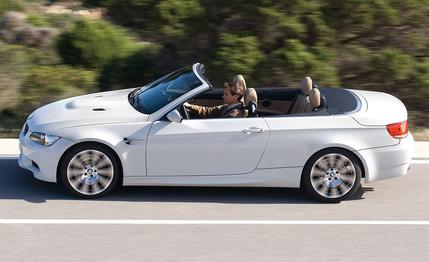
 Short Take Road Test
Short Take Road Test
The truth is that the convertible you see here isn’t much of an M3 beyond powerplant and badging. “Whaddya mean,” you wail. “It goes from 0 to 60 mph in under five seconds! It’s got 0.92 g of lateral grip! Plus the steering wheel’s all fat and full of colory stitching! Sounds like an M3 to me.”
You may have a point, but historically, the M3 is a model that makes no compromises. It’s a performance-tuned ballistic missile designed to obliterate expectations and competitors alike, a machine so perfectly in harmony with enthusiasts’ wants and desires that they wake up in the middle of the night mumbling its name under their breath, palms clammy with cold sweat.
But that all changes once you chop off the roof.
Gone is the I-beam structural rigidity. Added are several hundred speed-sapping pounds of electric-top wizardry. Introduced are very un-M-like quivers and jitters. In our minds, the M3 badge stands for dynamic purity, and the (relatively) flexy chassis and porky curb weight of the convertible result in a dilution of that ideal.
So the M3 convertible isn’t an M3 in the truest sense. What is it, then? Certainly nothing bad. In fact, it is the closest thing to a sports car that seats four real humans and has a roof that goes down. There are a few more visceral droptops out there, some of which claim to hold four people—the Porsche 911 Turbo cabriolet and its laughable rear seats, for example—but none offers such an intoxicating combination of practicality, speed, prestige, and modern technology as found in this car.
Gimme More of That Hot, Hot V-8
We can’t get enough of the M3’s stupendously awesome 4.0-liter V-8; you could strap it to a three-legged water buffalo and we’d be more than happy to take it for a spin. Our affection for the rev-happy eight-pot, of course, only grows with every sampling, and that was certainly the case with the M3 convertible.
The 414 horsepower and 295 lb-ft of torque provide plenty of motivation for the hefty, 4123-lb car, and our tests saw the M3 convertible hit 60 mph in a blistering 4.6 seconds. The car’s closest competitor, the Mercedes-Benz CLK63 AMG cabrio, does the deed in 4.2 seconds, but that car boasts advantages of 61 horsepower and 170 (!) lb-ft of torque. Quarter-mile times are commensurate in disparity, with the M3 turning 13.1 seconds at 109 mph and the CLK doing 12.5 at 116. It’s probably worth mentioning at this point that the Benz costs a staggering $92,975, some $25,000 more than the M3 convertible, which starts at a comparatively thrifty $67,475.
You Might Need Your Own Bailout after Finishing With the Options List
As with all BMWs, though, the base price can bloat like a week-old carcass once you get frisky with the options list. Our completely and totally loaded tester, for example, rang up at $80,170. Of that, $550 went toward metallic paint, $1100 toward swathing the cabin in Fox Red (and fantastic) leather upholstery, and $1250 toward the Premium package and its power-folding mirrors, sycamore wood trim, universal garage-door opener, and BMW Assist. An additional $2445 was divided among a Cold Weather package, rear parking sensors for people with broken necks (or broken mirrors), HD radio, Sirius satellite radio, and a wonderful iPod hookup. We’d go so far as to call the iPod integration the most intuitive thing about the old iDrive system as a whole—we’re happy to say that iDrive has been completely revamped for 2009, making this one of our last encounters with the previous generation.
The biggest dollars were tacked on for stuff that actually affected the car’s performance. The Technology package, the dual-clutch transmission, and the 19-inch wheels with Michelin Pilot Sport PS2 performance rubber totaled an additional $7350.
Along with navigation and keyless go, the Tech package adds electronic damping and the M Drive function, which allows the driver to preselect via iDrive his or her preferences for the dampers, throttle response, steering effort and response, and stability control, and enable them using the M button on the steering wheel.